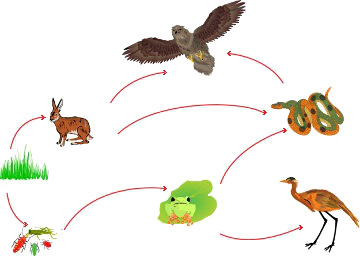At food chains, also called trophic chains, can be defined as a linear sequence of organisms in which one serves as food for the other. However, an organism is not present in just one food chain, because, in an ecosystem, the various existing chains are connected. The food chains connected in a given ecosystem are called food web.
In the food web, as well as in the food chain, we can group organisms at different trophic levels, that is, we can group beings that have similar eating habits. Organisms can be classified, therefore, into:
→ Producers: are the beings autotrophs, that is, that they are able to produce their own food. They always represent the first trophic level of a food chain or web. In this group, we have plants, algae and some bacteria.
→ Consumers: are organisms heterotrophic that feed on other living beings. A herbivore animal that feeds on a producer is an example of a consumer, as is an animal that feeds on that herbivore.
Consumers can be classified into primary, secondary, tertiary and so on. The primary ones are those that feed on the producers; the secondary are those that feed on the primary ones; the tertiary are those who feed on the secondary and so on.
→ Decomposers: They are heterotrophic organisms that carry out the decomposition process and act on all living beings. As an example of decomposers, we can mention fungi and bacteria.

Note that a food web is more complex than a chain
In a food web, unlike the food chain, which is linear, the same organism can occupy different trophic levels. In the above scheme, for example, the snake can be a secondary or tertiary consumer. When it feeds on the rabbit, which is a primary consumer because it fed on the leaves, it is classified as a secondary consumer; but when it feeds on the frog, it plays the role of a tertiary consumer in the ecosystem, as the frog feeds on insects, which are primary consumers.
The food web more faithfully represents an ecosystem, as it demonstrates the networks formed by different chains simultaneously. When we analyze just one food chain, we are only looking at a portion of the various food interactions that exist.
By Ma. Vanessa dos Santos
Source: Brazil School - https://brasilescola.uol.com.br/biologia/teia-alimentar.htm


